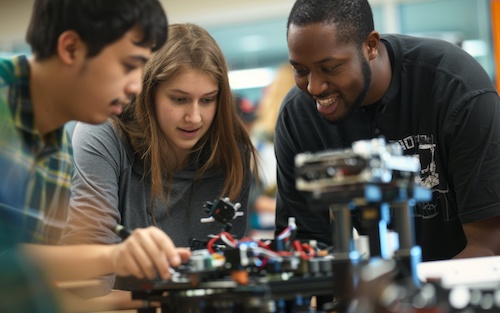
Hands-on learning will help Gen Alpha reach new levels of technical innovation
If we want Generation Alpha to create world-changing technologies, educators must embrace experiential learning resources and encourage collaboration
By Shanya Swaneet, STEAM Works Studio September 5th, 2024Key points:
- Students build conceptual understanding from experiential learning and retain information better
- 5 ways to use technology for classroom creativity
- 5 strategies to navigate science literacy in the digital age
- For more news on innovative learning, visit eSN’s Digital Learning hub
The pace of technological innovation is increasing exponentially. It’s hard to wrap our heads around the immense knowledge that future generations will possess. Generation Alpha will likely be the most technically innovative generation in history, but what will they do with that knowledge? How can we harness their skills to create world-changing technologies? The answer lies in immersive, hands-on learning experiences that start from a young age.
Students need engagement in hands-on activities such as robotics, electronics, animation, 3D printing, and physical computing, as well as art and music, to reach their full potential. I’ve seen firsthand how experiential learning opportunities encourage kids to build, create and innovate throughout their lives. Classroom learning can only go so far. Children need to build robots, make art, and compose music to understand the world and boost their creativity in profound ways.
Here are three crucial methods for tapping into a child’s creativity and why they encourage lifelong innovation.
Embrace hands-on projects to foster creativity and problem-solving skills
For kids to think creatively, they need to take risks and make mistakes. Hands-on projects provide the perfect opportunity. Physical projects allow kids to use materials in new ways, generating ideas and encouraging more frequent class participation.
Teachers can start experiential learning activities at the beginning of the school year to set the pace and tone of the classroom. Students will start to expect hands-on learning, which will engage them and encourage closer adherence to activity rules.
Exposing children to various hands-on projects like robotics, pottery and music production as early as possible allows them to hone their critical thinking, problem-solving and creative skills.
For example, if you give a middle school student a project to create their own Bluetooth speaker that plays music from a phone, they experience real-world problems. What if they insert the wires incorrectly or realize there’s a missing piece of hardware? This encourages attention to detail and creative problem-solving. The bigger and more ambitious the projects, the more confidence the student gains.
These skills form the backbone of technological innovation. To mentor the next generation of technology entrepreneurs, astrophysicists and creators of art and music, we must expose them to experiential learning. It helps them understand their true interests and can set the foundation for their entire career path.
Encourage collaboration, feedback and showcasing work in a safe environment
A safe learning environment is crucial for students to learn and thrive successfully. Allowing students to collaborate on projects frequently, showcase their work, and exchange feedback in a supportive way helps them feel safe and proud of themselves.
Throughout my career, I’ve witnessed students proudly sharing their projects with friends, families, fellow students, and teachers. The reactions they get make a huge impact. When feedback is constructive, it helps students master content and understand what they would do differently next time. A teacher or teammate might offer several ways of solving the same problem, reflecting the unique ways people think and understand the world. No gamified or AI-enabled platform can provide that kind of direct interaction.
Collaboration is also immensely valuable because it reflects how work is accomplished in the real world. In corporate settings, leveraging colleagues’ ideas is key to success. Sometimes no one knows the right answer, but team discussions can illuminate practical solutions. Collaboration is essential to the innovation process.
Take advantage of experiential learning resources
It’s my goal to help make hands-on learning resources available to educators nationwide, and they’re more accessible than most people think.
Numerous enrichment modules can be completed online and workshops around the country train teachers in hands-on learning curriculum. Lesson plans, video tutorials, and experiential learning kits (including materials like soldering irons, computers and microcontrollers) can be accessed for free via resources like Virtual Science Teachers, STEMfinity and STEM Activities for Kids.
When teachers have access to nontraditional curriculum, students benefit immensely. Students build conceptual understanding from experiential learning and retain information better, setting them on the path toward innovation.
If we want Generation Alpha to create world-changing technologies, educators must embrace experiential learning resources and encourage collaboration and supportive feedback for every student. By doing so, we can nurture the most technically innovative generation in history, equipping them with the skills and mindset to tackle the challenges of tomorrow.
About the Author:Shanya Swaneet is Chief Operating Officer of STEAM Works Studio. Shanya is an engineer with a background in Computer Science and Mathematics who has nurtured the company since its inception in 2014. A serial entrepreneur and licensed pilot, Shanya leads operations across US and international locations, championing hands-on applied education as a path to a more dialogic and harmonious society.